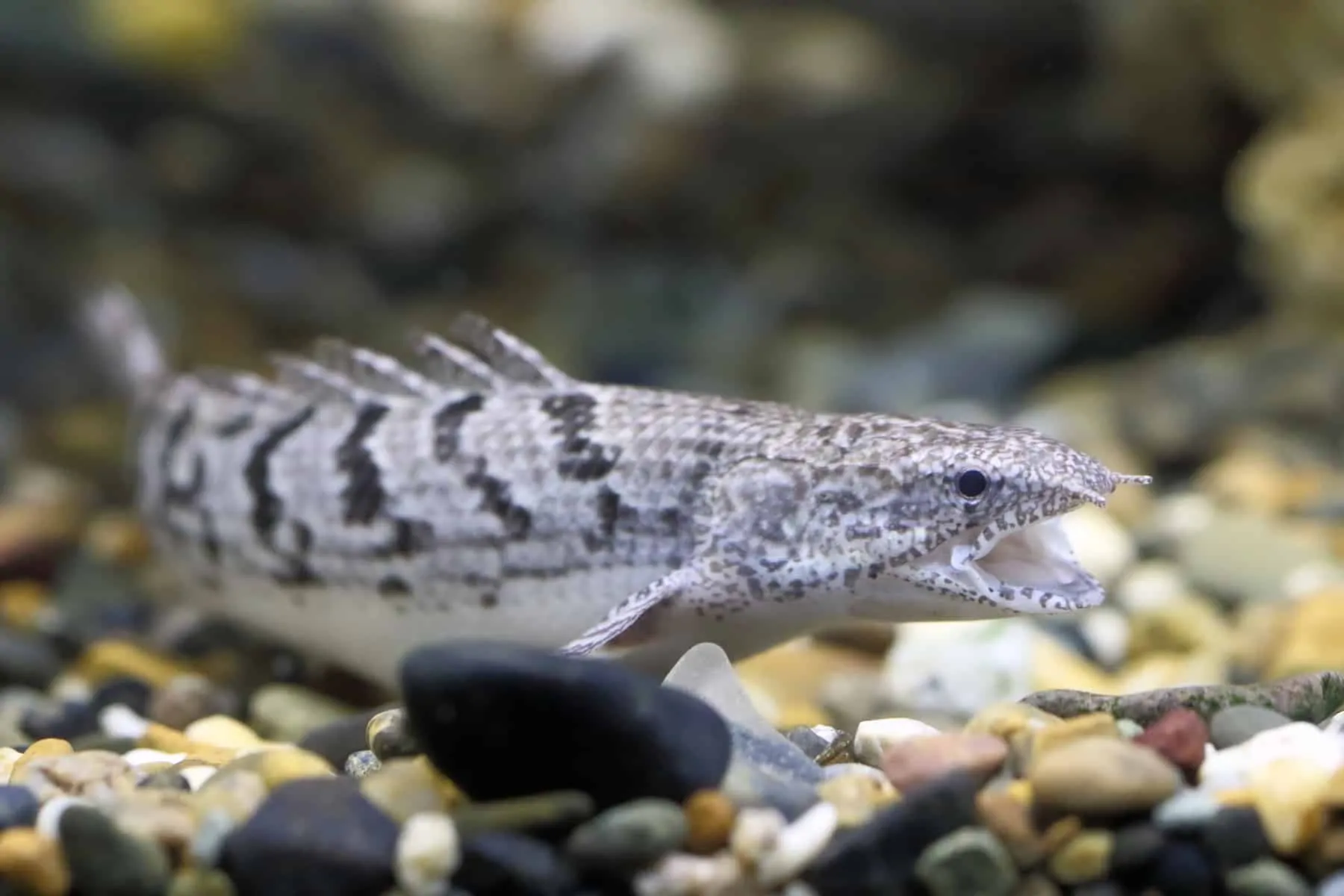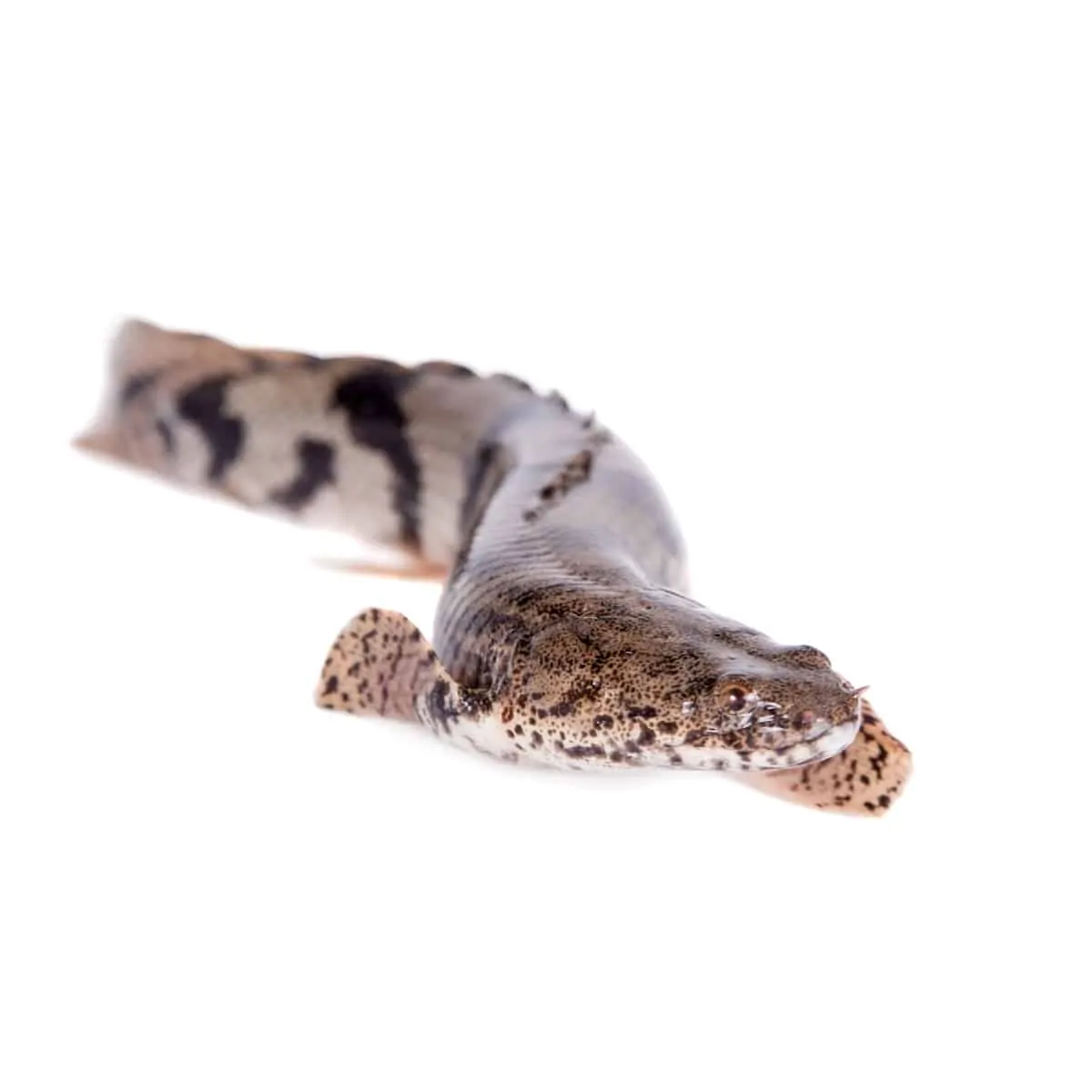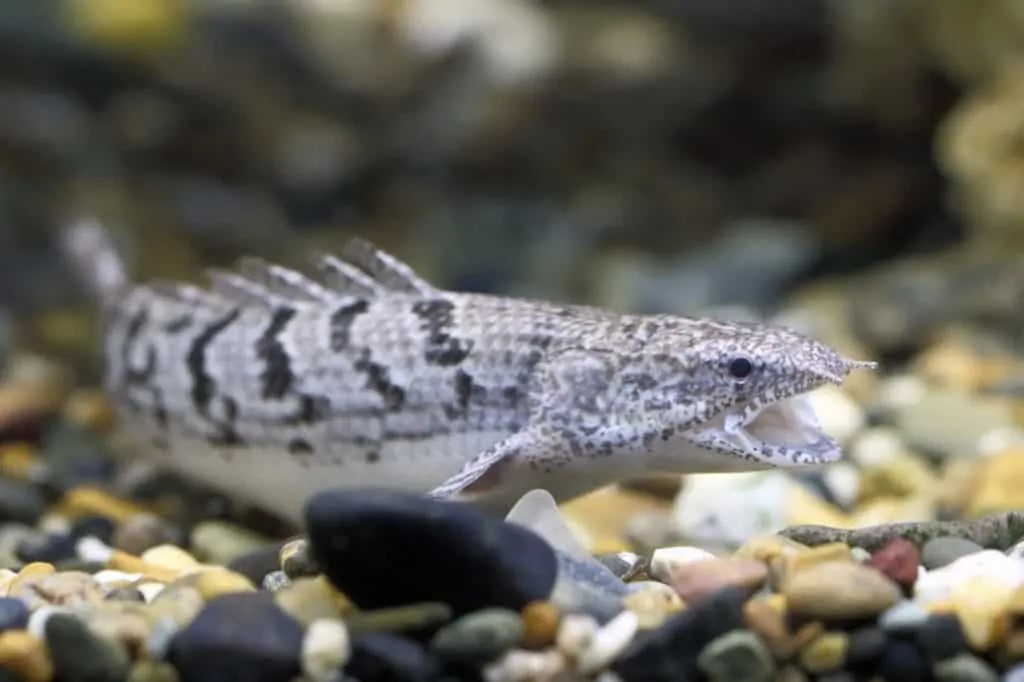The Senegal Bichir, scientific name polypterus senegalus, makes an unusual addition to a community tank setup. In this article, we introduce this fascinating fish and explain how to care for and breed bichirs.
What is a Senegal bichir?
Although the Senegal bichir looks rather like an eel, it is a species of primitive freshwater fish. It’s thought that the bichir fish has been around since the end of the Mesozoic era, around 60 million years ago.
Bichirs have long, eel-like bodies and dorsal finlets. The unique finlets have double-edged tips and range in number from seven to 18. The bichir’s other finnage is spineless, consisting of soft rays.
The bichir’s body is coated in sturdy, bony scales, giving the fish a prehistoric appearance. The wild bichir is a large fish, growing up to 38 inches in length. The name dinosaur eel is commonly used to refer to these fish, as well as dragonfish, and swamp dragon.
Senegal bichirs can be found throughout the tropical regions of Africa, where they live in sheltered lagoons, swamps, and marshes, thriving among the dense vegetation and muddy substrate. During the daytime, the bichir hides in murky nooks and crannies, coming out at night to search for the insects, larvae, crustaceans, mollusks, small frogs, and fish on which it feeds.
The Senegal bichir can breathe air at the water’s surface via a specialized swim bladder. These unique fish can also use their powerful pectoral fins as “legs” and are capable of crawling over short distances on land. For that reason, you must have a tightly-fitting lid on your tank to prevent your bichir from escaping.
The Senegal bichir is not a flashy fish. The polypterus senegalus is dull in color, appearing in various shades of black, brown, and gray. However, the Ornate bichir fish has intricate black and yellow patterning, which is more impressive than their drab counterparts.

Caring for the Senegal bichir
The polypterus is extremely hardy and pretty easy to care for. However, there are some essential requirements that you must provide if you want to ensure that this ancient species remains healthy and reaches its ten-year life expectancy.
Tank size
Polypterus senegalus may grow to reach 16 inches in length in captivity. So, you will need an aquarium of at least 6ft x 2ft x 2ft with a 50-gallon capacity to accommodate this species.
The aquarium must have a tightly-fitting lid to prevent your senegalus from escaping, and any gaps must be plugged securely with mesh or filter foam. You must leave a gap of at least two inches between the water surface and the aquarium lid to allow your fish to breathe. If the bichir is denied access to the air above the water’s surface, it may drown.
Substrate and decoration
You should use a soft, sandy substrate, as these fish spend much of their time foraging on the bottom of the tank.
Provide plenty of shady hiding places by creating rocky caves and dense planting, and use natural decoration, such as driftwood and water-worn rocks.

Lighting
Polypterus have poor eyesight and prefer a dimly-lit habitat, where they use their keen sense of smell to search for food. You could use plants to diffuse the light and provide the twilight world that’s preferred by these ancient creatures.
As these creatures are nocturnal, a blue moon light on a timer that’s set to come on when the main aquarium light switches off will allow you to watch the fish as they feed.
Water conditions and filtration
In their wild environment, senegalus live in relatively still water, so you should use a filtration system that generates a gentle current. Weekly water changes are also recommended to keep nitrate levels low.
The species is easy to please when it comes to water parameters and will be happy in water with pH levels of between 6 and 8. That said, bichirs are a tropical species, so the water temperature should be between 77 degrees and 84 degrees Fahrenheit.
Tankmates
Although the Senegal bichir is a predatory carnivore, they can live peacefully in a community tank, provided that their tankmates are at least half the size of the bichir.
Suitable tankmates for bichirs include:
- Large species of catfish
- Pleco
- Silver dollar
- Oscar
- Two-spot cichlid
- Bandit cichlid
You can keep senegalus in groups, although all specimens must be of a similar size, and you must provide plenty of hiding places too so that the fish can form separate territories, as they won’t willingly share.
Feeding
The bichir is a carnivore, and very rarely eats dried foods. Therefore, a diet of frozen or live foods is recommended for larger fish, including shrimp, baitfish, mussels, and earthworms. Smaller specimens will also eat mosquito larvae, bloodworms, and vitamin-enriched brine shrimp.
Bichirs are quite slow feeders, so ensure that each fish receives an adequate share of the food.

Breeding
Breeding polypterus in captive-kept specimens is challenging, but it can sometimes be done if tank conditions are right.
Wild senegalus breed during the rainy season. During their graceful courtship ritual, the female and male swim in parallel through thick clumps of vegetation, occasionally jumping out of the water before sinking down again. When the female is ready to spawn, she stops swimming, and the male wraps his anal fin around her to form a cup. The female then deposits her eggs into the cup where the male fertilizes them.
The eggs are dispersed by powerful movements of the male’s tail, floating into the vegetation where they adhere to leaves. After three or four days, the eggs hatch, remaining attached to the vegetation until the fry has absorbed their yolk sacs. Once free-swimming, the fry should be offered baby brine shrimp.
Neither parent takes any part in raising their family, and the growing juveniles are left to fend for themselves in a world full of fish looking for a meal. For that reason, you should remove the youngsters and keep them in a separate set up until they are big enough not to be lunch for other fish.
FAQs
Here are few frequently asked questions about the fascinating Senegal bichir.
Q: How big do Senegal bichirs get?
A: Captive bichirs can grow to be 18 inches long, whereas wild specimens can be over two feet long.
Q: Are Senegal bichirs aggressive?
A: Senegals are generally peaceful fish. However, they are carnivores and will usually eat smaller tankmates.
Q: What size tank does a bichir need?
A: Bichirs need an aquarium of at least 50 gallons in capacity.
Q: Is a bichir an eel?
A: No. A bichir is a primitive fish. The family of polypterus first appeared over 60 million years ago.
Final thoughts
The Senegal bichir is a highly unusual fish of the Polypteridae family that can be kept in a community setup, provided that the tankmates you choose are large and relatively peaceful.
Although the species is relatively straightforward to keep, you will need plenty of space for a big aquarium. Bichirs don’t do well unless they are fed live food and are perhaps best-suited to experienced hobbyists.


